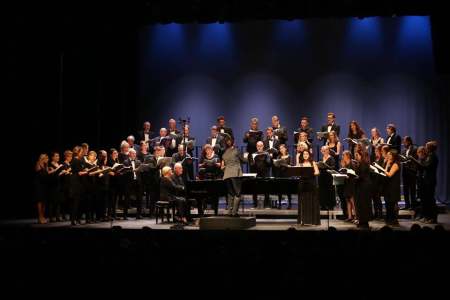‘HXOS Chor Berlin (choirmaster: Stelios Chatziktoris) and “Polyfonia” Chamber Choir (choirmaster: Maro Skordi) join their voices to present Johanness Brahms’ masterpiece A German Requiem (Ein Deutsches Requiem, op. 45) in its version with piano duet accompaniment. The concerts will also include a capella works by ‘HXOS Chor Berlin.
The concert will be conducted by Stelios Chatziktoris and the solo parts will be interpreted by Mariza Anastasiades (soprano) and Stavros Mantis (baritone). Piano duo accompaniment: Elina Linchevskaya and Zbynek Maruska.
A German Requiem, to Words of the Holy Scriptures, οp. 45 (German: Ein deutsches Requiem, nach Worten der heiligen Schrift) by Johannes Brahms, is a large-scale work for symphony orchestra, four-part chorus, soprano and baritone soloists composed between 1865 and 1868. It is unquestionably one of the greatest masterpieces of this genre. A German Requiem was premiered in Leipzig on 18 February 1869 with the Gewandhaus Orchestra and Chorus, and soloists Emilie Bellingrath-Wagner and Franz Krückl. At the beginning of the same year, Brahms prepared an alternative version of the work with piano duet accompaniment. In a letter on January 30th 1868 the composer writes: “I have devoted myself to a noble occupation: arranging my immortal work so that it can also be enjoyed by four-handed souls. Now it can not perish.”
In contrast to the traditional Roman Catholic Requiem Mass, which employs a standardized text in Latin, the text is derived from the German Luther Bible. Brahms's first known use of the title Ein deutsches Requiem was in an 1865 letter to Clara Schumann in which he wrote that he intended the piece to be "eine Art deutsches Requiem" (a sort of German Requiem). German refers primarily to the language rather than the intended audience. Brahms stated once to the director of music at the Bremen Cathedral, that he would have gladly called the work "Ein menschliches Requiem" (A human Requiem). Although the Requiem Mass in the Roman Catholic liturgy begins with prayers for the dead ("Grant them eternal rest, O Lord"), A German Requiem focuses on the living, beginning with the text "Blessed are they that mourn, for they shall be comforted." from the Beatitudes. Although the idea of the Lord is the source of the comfort, the sympathetic humanism persists through the work.
Supported by: Goethe Institut


